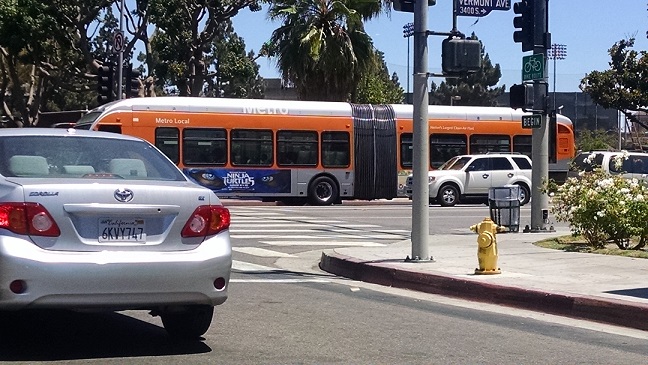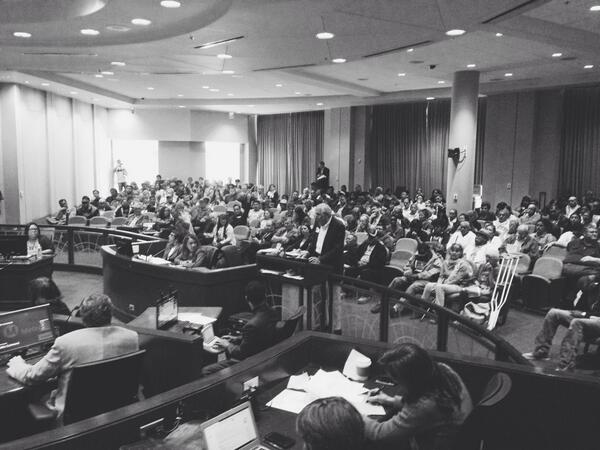Exceptional Transit: How L.A. Metro Failed Low-Income Riders

Ask anyone who’s ever used L.A. transit this question and they’ll probably tell you that, yes, it is exceptional—exceptionally bad.
But while L.A.’s transit services may seem mediocre at best, there is no doubt that the system has exceptional needs. Despite rising operating costs and a deficit that could reach $36.8 million by 2016, L.A. Metro is going forward with ambitious expansion plans for its existing rail system, with two more lines set to begin construction soon. While such expansion is widely regarded as necessary, the costly undertaking has only augmented concerns of the Metro Board of Directors about the system’s sustainability. With fares funding just 26 percent of its operating budget, L.A. Metro is one of the most subsidized transit networks in the world.
READ MORE: Crenshaw's 'Railway To The Future'
Concerned that Metro’s poor returns would jeopardize their chance of receiving future federal grants, the Metro Board voted last May to raise fares for the city’s public bus and rail systems, from $1.50 to $1.75 per ride. Prices for day and monthly passes will also increase significantly, from $5 to $7, and $75 to $100, respectively.
But L.A. County Supervisor Gloria Molina, the only Board member to vote against the increase, believes that if Metro’s operating budget is too high, the burden shouldn’t fall on passengers to fix it.
“We should abandon that model. It doesn’t make sense,” she said of the Board’s goal to increase revenue to 33 percent of operating costs. “There is no other bus system in the country that has a more dramatic number of low-income and minority bus riders. Those are unbelievable and startling figures that this organization has to come to grips with.”
In other words, the reason L.A.’s metro is so heavily subsidized is because it needs to be. Metro riders quite literally can’t afford to pay more.
READ MORE: MTA Board Votes To Increase Bus, Train Fares
Consider that the median household income of an L.A. bus rider is just $16,250 a year, which works out to a measly $1,354 a month. That’s already less than the average monthly rent for an L.A. apartment in 2013 ($1,425), but even if you budget rent at just $900—the price of a roach-infested studio in most neighborhoods—that leaves just $454 left over to pay for groceries, utilities, clothing, toiletries, out-of-pocket medical expenses, cell-phone bills, insurance and any other miscellaneous expenses, into which a $100 metro pass now somehow has to fit. There’s no room for kids in that budget, though many bus riders have them, and are doing their damndest to make it work. For the Metro Board to increase fares for these people a full $300 a year? That’s not just kicking them while they’re down—it’s curb stomping.
Put another way, bus riders will now be spending an average 7.4 percent of their income on simply getting to and from work each day. That’s the equivalent of making $100,000 a year and spending enough money on gas to support a daily commute to Santa Barbara and back—at L.A. gas prices to boot.
It is a troubling testament to socioeconomic inequality that being poor in America is literally more expensive than being rich. When you can’t afford health insurance, you end up paying more for healthcare in the long-run. When you don’t have access to the internet, you miss out on money-saving deals and services like Craigslist. When you live in an underfunded school district, you have to pay money so that your child can take the bus to school (a 30-day student Metro pass in L.A. costs $24).
READ MORE: County Education Coordinating Council Pushes For Free Student Metro Passes

According to the Los Angeles Times, Metro Board member and L.A. City Council Member Mike Bonin at least attempted to throw lower-income riders a bone, by pushing the Board “to make it easier for low-income riders to find out about the agency's fare subsidy programs, including advertising at train stations and bus stops and working with community groups, including churches.”
But the Metro’s Rider Relief Program, or RRTP, only allows for a discount of $10 off a monthly pass, which won’t make up for the $25 increase. Additionally, at $28,550, the maximum household income for RRTP eligibility is $12,000 higher than the median household income of Metro bus riders, and $8,000 higher than the median household income of Metro rail riders ($20,770)—meaning that almost everyone who rides the Metro is eligible for the discount in the first place. Why not just build the low-income discount into the regular fare? Because then people would actually be able to use the discount. As it stands, RRTP is drastically underutilized—not only because, as Bonin suggested, it’s almost impossible to find information about the program unless you google “LA Metro RRTP,” but because the process of applying for reduced fare involves making an appointment with one of two third-party organizations (which organization depends on where you live), neither of whose websites have instructions in a language other than English, and one of which lists stricter eligibility requirements than those posted on the Metro website.
The RRTP, which Bonin so gallantly drew attention to but which the Metro Board took no concrete actions to actually improve, is about as much of a farce as the Board’s supposed interest in rider input on the changes. Crowds of literally hundreds showed up at every public hearing leading up to the Board’s vote to declare their opposition to a fare increase. More than 130 people spoke publicly at the final hearing alone asking Metro directors to lower fares or keep them at their current levels. Many testified, some in tears, that an increase in fares would mean losing their homes or choosing between buying food and buying bus tickets.
As our elementary-level number crunching plainly shows above, this isn’t just a facetious appeal to emotion. It’s frankly a miracle if Metro’s low-income riders aren’t already choosing between a bus pass and their next meal, or a trip to the Laundromat, or shin guards for their kids, or fixing the broken lock on the back door.
But riders are making these choices and they will continue to do so, because that’s what it takes to keep any food on the table at all. That’s what defines the difference between working to survive and not surviving. They will choose survival, as they have all their lives, but it will come at a cost—a cost unseen to the Metro Board members and the more prosperous Los Angeles that couldn’t be bothered to come up with a better way to fix our metro system than “on the backs of the very poor.”
Stay tuned for 'Exceptional Transit,' Part 2: The Case For Federal Investment In L.A. Metro
Contact Senior Opinion Editor Francesca Bessey here; follow her here.



